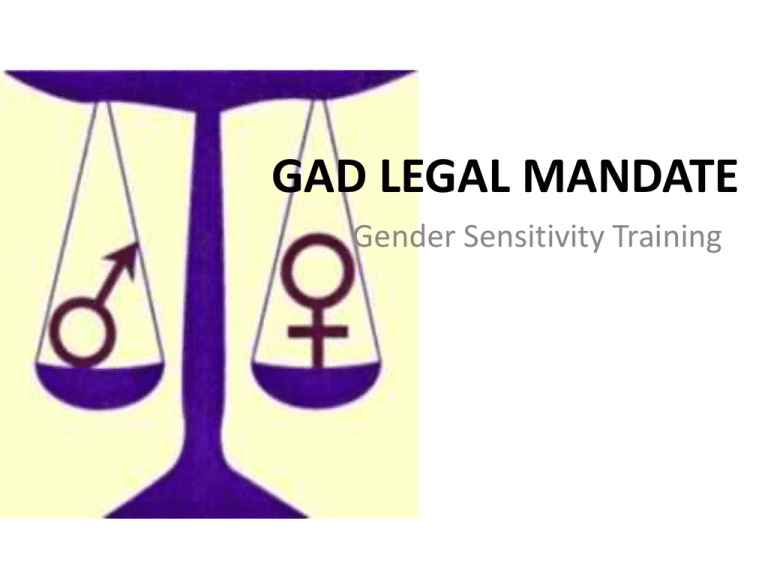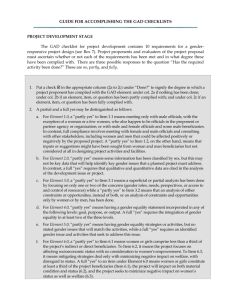
GAD LEGAL MANDATE
Gender Sensitivity Training
Topics
1.
2.
3.
4.
5.
6.
Socio-cultural and Legal Framework
Gender Bias
Aims and Legal Mandates
Laws on GAD
Government Commissions
Development Plan for Women
Socio-Cultural and Legal Framework
• Biological determinism
– Women have weaker physique
– Women are for motherhood
• Child-bearing
• Child-rearing
• Housekeeping
– This gave rise to working woman’s “double
burden.”
• Hampers their intellectual and career development
Socio-Cultural and Legal Framework
• Production/Reproduction Dichotomy
• Women are for the home and men are for the
public
– Those who belong to the public sphere (usually
men) are perceived to have primacy in society
because of their productive function. Women are
relegated to the reproductive function and are
perceived to be confined to secondary pursuits.
– Women are supportive while men take the
dominant role.
Before
At home after work…
Now
At work
At home after work…
• DOUBLE BURDEN
Socio-Cultural and Legal Framework
• Women's contributions have remained both largely
invisible to the public eye as well as merely secondary
in perceived functions
• women's active participation in public life has not been
as extensive as that of men
• It is this very subordination that also accounts for the
lack of support systems and social benefits for women.
• The limited access and control that women have over
resources, and the comparatively minor roles that
women play in the national drama of development.
GENDER BIAS
any gender-based distinction,
exclusion, or restriction which
has the effect or purpose of
impairing or nullifying the
recognition, enjoyment, or
exercise by women,
irrespective of their marital
status, on a basis of equality of
men and women, of human
rights and fundamental
freedoms in the political,
economic, social, cultural, civil
or any other field
•
•
•
•
Education
Experience
Skills
HIRED
•
•
•
•
Education
Experience
Skills
NOT HIRED
BECAUSE
SHE’S
FEMALE
•
•
•
•
Education
Experience
Skills
HIRED
•
•
•
•
Education
Experience
Skills
NOT HIRED
BECAUSE
SHE’S
PREGNANT
Gender Bias
• Marginalization
– Production/reproduction
dichotomy
– Non-valuation of women’s
function (family care as
mere natural function)
– Last hired, first fired
– Gap in salaries
– Limited access to trainings
and promotions
– Sexual Harassment in the
work place simply
construed as an
“occupational hazzard”
Gender Bias
• Subordination
– In politics and tradition,
women do not share the
same power, prestige,
status, and societal
position as men
– Women are generally
given “supportive roles.”
• Home, Community,
Nation
– This limits their
participation in decisionmaking and assumption
of leadership positions
Gender Bias
• Stereotyping
– Family socialization,
educational system, career
options, portrayal of
women in media, teachings
of various religious groups
– women as weak,
dependent, subordinate,
indecisive, emotional, and
submissive.
– Virgin or vamp
– Women are trapped and
limited by these
stereotypes
Gender Bias
• Multiple Burden
– House work and child care
+ work outside the house
– women work in
agriculture, fisheries,
manufacturing, service
occupations, the informal
sector, industry, and the
various professions
– women also participate in
socio-cultural and political
activities in community
affairs, church-related
functions, civic activities,
and political involvements
Gender Bias
• Violence
– Born out of the status of
women in the society
– Verbal and psychological
abuse
– Physical and sexual
harassment
– From the childhood
"games" of boys peeping at
girls to various acts of
lasciviousness, from
seduction to abduction,
from molestation to wife
beating, from prostitution
to rape
Gender Bias
• Personal
– Society limits a
woman’s right to be
human
– Reproductive rights
and sexuality are
constrained
– Women’s health
Aims and Legal Mandates
1. Alter the traditional concept that a woman’s selfworth as being subordinate to men.
– Requirements:
• Commitment to personal growth, both intellectually and
creatively
• Motivation to take care of one’s self
• Consciousness-raising
– Sufficient Support Mechanism (e.g. Child care support
system)
– Programs for capacity enhancement
– Manifestation of attainable goals and role models
Aims and Legal Mandates
2. For Filipinos to recognize and
acknowledge childbearing and
rearing as vital societal functions
– Genuine recognition of the value of
reproductive sphere
– Sharing of responsibilities in the
family and parenting
– Family violence
• Institutional support for women
victims of violence
Aims and Legal Mandates
3. Installation of non-sexist education
– Textbooks and school curricula need to be
analyzed and shorn of discriminatory
stereotyping, language and career options
– Rearing of the children will have a great impact
4. Removal of stereotyping in Media
5. Examine discrimination against women in
religious tenets and institutions
Aims and Legal Mandates
6. Ensure equal opportunities for both women
and men in formal/nonformal education and
on-the-job training.
– Acquisition of non-traditional skills for women
– Recognizing the childbearing function of women,
training programs for women must be set up in
order to ease their re-entry into the labor force
after the childbearing/rearing period
Aims and Legal Mandates
7. Equal pay for equal work
– change the patterns of sex discrimination in hiring and
promotion
8. Women-friendly technology and infrastructure
9. Greater participation in decision-making,
especially with regard to prices of commodities
– women are largely responsible for consumption in the
home
Aims and Legal Mandates
10. ensure the equal rights between women and
men.
– property rights, citizenship rights, safety standards
and equal opportunities
– Legal sanctions must be instituted
– Legal literacy
Laws on GAD
• Constitutional Basis
– Art. II, Sec. 14, 1987 Constitution
• “The State recognizes the role of women in nation-building,
and shall ensure the fundamental equality before the law of
women and men.”
– Art. XIII, Sec. 14, 1987 Constitution
• “The State shall protect working women by providing safe
and healthful working conditions, taking into account their
maternal functions, and such facilities and opportunities that
will enhance their welfare and enable them to realize their
full potential in the service of the nation.”
Laws on GAD
• Constitutional Basis
– Art. XIII, Sec. 11, 1987 Constitution
• “The State shall adopt an integrated and comprehensive approach to
health development which shall endeavor to make essential goods,
health and other social services available to all the people at
affordable cost. There shall be priority for the needs of the underprivileged, sick, elderly, disabled, women, and children. The State shall
endeavor to provide free medical care to paupers.”
– Art. IV, Sec. 1(2), 1987 Constitution
• Section 1. The following are citizens of the Philippines:
• [1] Those who are citizens of the Philippines at the time of the
adoption of this Constitution;
• [2] Those whose fathers or mothers are citizens of the Philippines;
• [3] Those born before January 17, 1973, of Filipino mothers, who elect
Philippine citizenship upon reaching the age of majority; and
• [4] Those who are naturalized in accordance with law.
Laws on GAD
• Constitutional Basis
– Article II, 1987 Constitution
• Right to health
• Right to a balanced and healthful ecology
• Right to education
– Art. III, 1987 Constitution
•
•
•
•
•
Right to life, liberty and property
Right to equality and non-discrimination
Freedom of expression
Right of Assembly and associations
Freedom of movement
Laws on GAD
• Statutory
– RA 9710, Magna Carta of Women
•
•
•
•
Rights of Women
Inter-sectoral Implementation
Mainstreaming as form of implementation
It mandates
– (a) planning, budgeting, monitoring and evaluation for gender
and development,
– (b) the creation and/or strengthening of gender and development
focal points, and
– (c) the generation and maintenance of gender statistics and sexdisaggregated databases to aid in planning, programming and
policy formulation.
• Funding
Problems
• Is the pregnancy of an unwed student a
ground for expulsion?
• Is the pregnancy of an unwed faculty member
a ground for dismissal?
• Is the adulterous pregnancy of a married
faculty member a ground for dismissal?
Laws on GAD
• Statutory
– EO 227, The New Family Code of the Philippines
– RA 7192, the Women in Development and Nation Building Act which
promotes the integration of women as full and equal partners of men
in development and nation building
– RA 6725, An Act Strengthening the Prohibition on Discrimination
against Women with Respect to Terms and Conditions of Employment,
Amending 135 of the Labor Code, as Amended.
• Joint Circular No. 2012-01 (GAD Plans and Budgets and Accomplishment
Report Implementing MCW)
– RA 7877, Anti-Sexual Harassment Act, which declares sexual
harassment unlawful in the employment, education and training
environment
– RA 6949 declares March 8 of every year as a working holiday to be
known as National Women's Day
Problem
• Although they have no impediment to marry each
other, X and Y are living together without the benefit of
marriage;
• X, the common law husband, is the only one working;
• Y, the common law wife, manages the household;
• During their union, they established a estate
amounting to P6M;
• X broke up with Y because the latter cannot give him a
child.
• In the liquidation and distribution of the estate, how
much will go to Y?
Answer
• P3M, or one half of the estate.
• Art. 147. When a man and a woman who are
capacitated to marry each other, live exclusively
with each other as husband and wife without the
benefit of marriage or under a void marriage,
their wages and salaries shall be owned by them
in equal shares and the property acquired by
both of them through their work or industry shall
be governed by the rules on co-ownership.
Answer
• In the absence of proof to the contrary,
properties acquired while they lived together
shall be presumed to have been obtained by their
joint efforts, work or industry, and shall be owned
by them in equal shares. For purposes of this
Article, a party who did not participate in the
acquisition by the other party of any property
shall be deemed to have contributed jointly in
the acquisition thereof if the former's efforts
consisted in the care and maintenance of the
family and of the household.
Financial Support
Problem
• “I am pregnant and the father of my
child is a married man. Can I compel
him to financially support our child
once he is born? Can I also seek
reimbursement from the father for
all the expenses that I incurred
during the pregnancy once my child
is born?”
Answer
• Yes to the financial support.
• Yes to the reimbursement, if there is a legal
demand.
• Child is illegitimate (Art. 165, Family Code)
who is entitled to financial support from the
parents.
• REQUIREMENT:
– RECOGNITION BY THE FATHER
– PROOF OF AFFILIATION
Answer
• PROOF
1) record of birth appearing in the civil register
or a final judgment; and
2) an admission of illegitimate filiation in a
public document or a private handwritten
instrument and signed by the parent
concerned.
Answer
In the absence of the foregoing evidence,
illegitimate filiation shall be proved by:
1) open and continuous possession of the status
of a legitimate child; or
2) 2) any other means allowed by the Rules of
Court and special laws (Article 172, Family
Code of the Philippines).
STEPS
• UPON BIRTH: ask the father to recognize him
as his illegitimate child by accomplishing the
Affidavit of Acknowledgment/ Admission of
Paternity found at the back of his birth
certificate.
• If your child has been recognized by his father,
he shall have the right to receive financial
support from him.
STEPS
• REFUSAL: Seek redress from the court by filing
a petition for compulsory recognition and
support.
• NOTE: A recognized illegitimate child shall also
have the right to use the surname of his father
(Section 1, RA 9255), and the right to inherit
from him through succession (Article 887, Civil
Code of the Philippines).
Laws on GAD
• Statutory
– RA 7877, Anti-Sexual Harassment Act, which
declares sexual harassment unlawful in the
employment, education and training environment
Problem
• Mr. X is an employer;
• A is a hardworking employee;
• Mr. X opened a position for
promotion;
• A applied but was denied by Mr.
X;
• Mr. X invited A to have a date
with him, out of town for three
days.
• Is there sexual harassment?
Laws on GAD
• (1) In a work-related or employment environment, sexual
harassment is committed when:
(a) The sexual favor is made as a condition in the hiring or in
the employment, re-employment or continued employment of
said individual, or in granting said individual favorable
compensation, terms of conditions, promotions, or privileges; or
the refusal to grant the sexual favor results in limiting,
segregating or classifying the employee which in any way would
discriminate, deprive or diminish employment opportunities or
otherwise adversely affect said employee;
(b) The above acts would impair the employee's rights or
privileges under existing labor laws; or
(c) The above acts would result in an intimidating, hostile,
or offensive environment for the employee.
Laws on GAD
• 2) In an education or training environment, sexual
harassment is committed:
– (a) Against one who is under the care, custody or
supervision of the offender;
– (b) Against one whose education, training, apprenticeship
or tutorship is entrusted to the offender;
– (c) When the sexual favor is made a condition to the giving
of a passing grade, or the granting of honors and
scholarships, or the payment of a stipend, allowance or
other benefits, privileges, or consideration; or
– (d) When the sexual advances result in an intimidating,
hostile or offensive environment for the student, trainee or
apprentice.
Problem
• A is employed in Establishment X (private);
• She has been paying conscientiously her
monthly maternity contributions for almost
two years now;
• She suffered from miscarriage;
• She is still employed;
• How much maternity benefit will she receive?
Answer: RA 7322
• She shall be paid a daily maternity benefit equivalent to one
hundred percent (100%) of her present basic salary,
allowances and other benefits or the cash equivalent of such
benefits for sixty (60) days;
• subject to the following conditions:
• "(a) That the employee shall have notified her employer of
her pregnancy and the probable date of her childbirth which
notice shall be transmitted to the SSS in accordance with the
rules and regulations it may provide;
• "(b) That the payment shall be advanced by the employer in
two equal installments within thirty (30) days from the filing
of the maternity leave application:
• In case of a cesarean delivery, the employee shall be paid
the daily
• maternity benefit for seventy-eight (78) days;
• "(d) That payment of daily maternity benefits shall be a bar
to the recovery of
• sickness benefits provided by this Act for the same
compensable period of sixty
• (60) days for the same childbirth, abortion, or miscarriage;
• "(e) That the maternity benefits provided under this
Section shall be paid
• only for the first four deliveries after March 13, 1973;
• "(f) That the SSS shall immediately reimburse the employer of one
hundred percent (100%) of the amount of maternity benefits
advanced to the employee by the employer upon receipt of
satisfactory proof of such payment and legality thereof; and
• "(g) That if an employee should give birth or suffer abortion or
miscarriage
• without the required contributions having been remitted for her by
her employer to the SSS, or without the latter having been
previously notified by the employer of the time of the pregnancy,
the employer shall pay to the SSS damages equivalent to the
benefits which said employee would otherwise have been entitled
to, and the SSS shall in turn pay such amount to the employee
concerned."
Problem
•
•
•
•
Mr. X is a teacher;
A is his student;
A failed in the subject of Mr. X;
Mr. X asked A to talk to him after his 7 PM
class alone;
• Is there sexual harassment?
Answer
• Yes, there is “probable ground for filing” a
sexual harassment case.
• But as to the liability of the Mr. X, it shall be
proven in the case. The allegation must be
substantiated by other evidence.
Laws on GAD
• A 6972 mandates the establishment of day
care centers in every barangay
• RA 7322 increases the maternity benefits of
women in the private sector;
• RA 7655 increases the minimum wage of
domestic helpers;
• RA 10361 Batas Kasambahay;
• RA 9262 Anti-Violence Against Women and
Children
Problem
•
•
•
•
•
Mr. X and Mrs. Y are married;
Mr. X is the breadwinner;
Mrs. Y is a plain housewife;
They have a misunderstanding;
Mr. X told Mrs. Y that she will not receive any
financial support from him if she will not listen
to him.
• Is there an act of violence under R.A. 9262?
Answer
• Yes, there is economic abuse.
• Threatening to deprive or actually deprive the
woman or her children of financial support
legally due her or her family, or deliberately
providing the woman’s children, insufficient
financial support.
Problem
•
•
•
•
•
Mr. X and Mrs. Y are common law spouses;
Mr. X is the breadwinner;
Mrs. Y is a plain housewife;
They have a misunderstanding;
Mr. X told Mrs. Y that she will not receive any
financial support from him if she will not listen
to him.
• Is there an act of violence under R.A. 9262?
Answer
• Yes
• “Violence against women and children refers to any act
or series of acts committed by any person against a
woman who is his wife, former wife, or a woman with
whom the person has or had a dating or sexual
relationship, or with whom he has a common child, or
against her child…”
• Threatening to deprive or actually deprive the woman
or her children of financial support legally due her or
her family, or deliberately providing the woman’s
children, insufficient financial support.
Problem
• X and Y are sweethearts;
• Y, the girl, wants to breakup with X;
• Not wanting to let Y go, X threatened Y that he
will commit suicide if she will not go back to
him;
• Is there violence against women?
Answer
• Yes.
• “Inflicting or threatening to inflict physical
harm on oneself for the purpose of controlling
her actions or decisions.”
Problem
• Mr. X is obsessed with Ms. Y;
• He keeps on following her wherever she goes;
• He even lingers outside her residence when
she goes home;
• Is there violence against women?
Answer
• Yes.
• “Stalking or following the woman or her child
in public or private places;”
• “Peering in the window or lingering outside
the residence of the woman or her child;”
• “Causing mental or emotional aguish…”
Question
• If you are a victim of violence under
R.A. 9262, what remedies are
available for you?
Answer
• 1. Petition for Protection Order
+
• 2. File any of the following :
– Criminal Action
– Criminal Action with reservation of separate civil
action
– Civil Action for Damages
Question
• Who may file?
Answer
– Offended party
– Parents or guardians
– Ascendants, descendants or collateral relatives
within fourth civil degree of consanguinity/affinity
– Officers/social workers of DSWD or LGUs
– Police officerrs
– Punong Barangay/Kagawad
– Lawyer
– At least 2 Responsible Citizens
Question
• Is the husband mandated to surrender
his salary to his wife?
Answer
• No.
• Prerogative of the spouses; not a duty.
Laws on GAD
• RA 6955 outlaws the practice of matching Filipino
women for marriage to foreign nationals on a mailorder basis;
• RA 10354 Reproductive Health Law which
emphasizes on:
–
–
–
–
–
–
–
Equality and non-discrimination
Sustainable human development
Right to health which includes reproductive health
Right to education and information
Gender equality
Inviolability of marriage
Reproductive health care services
Laws on GAD
• Civil Service Commission Memorandum
Circular No. 12, Series of 2005 which
encourages all heads of Constitutional Bodies,
Departments, Bureaus, Offices and agencies
of the national government, local government
units, state universities and colleges,
government owned and controlled
corporations the use of non-sexist language in
all its official documents, communications
and issuances
Laws on GAD
• UN Convention on the Elimination of All Forms
of Discrimination against Women (CEDAW)
• Universal Declaration of Human Rights
• Millennium Development Goals
– No. 3 which requires governments to promote
gender equality and empower women
Laws on GAD
• Yogyakarta Principle
– the Application of International Human Rights Law In
Relation to Sexual Orientation and Gender Identity
– “Using even the most liberal of lenses, these Yogyakarta
Principles, consisting of a declaration formulated by
various international law professors, are – at best – de lege
ferenda – and do not constitute binding obligations on the
Philippines. Indeed, so much of contemporary
international law is characterized by the “soft law”
nomenclature, i.e., international law is full of principles
that promote international cooperation, harmony, and
respect for human rights, most of which amount to no
more than well-meaning desires, without the support of
either State practice or opinio juris.”
Laws on GAD
• we cannot help but observe that the social issues
presented by this case are emotionally charged,
societal attitudes are in flux, even the psychiatric
and religious communities are divided in
opinion. This Court’s role is not to impose its
own view of acceptable behavior. Rather, it is to
apply the Constitution and laws as best as it can,
uninfluenced by public opinion, and confident in
the knowledge that our democracy is resilient
enough to withstand vigorous debate.
Government Commissions
• National Commission on the Role of Filipino
Women (NCRFW)
– Created in 1975 as a response to International
Women’s Year
– Its mandate is to work towards the full integration
of women for social, economic, political and
cultural development at national, regional and
international levels on a basis of equality with
men
Government Commissions
• Bureau of Women and Young Workers of DOLE
– Revitalized after 1986 government reorganization
• Bureau of Agricultural Extension of DA
– Revitalized after 1986 government reorganization
• Bureau of Women’s Welfare under DSWD
• Presidential Proclamation No. 227
– March as Women’s History Month
• Presidential Proclamation No. 224
– March as the Women’s Month
• Commission on Human Rights
Development Plans for Women
• The Philippine Development Plan for Women
1989-1992, (PDPW)
– Approved and adopted by EO 348
– Served as the government blueprint for integrating
women in the development process, was a significant
accomplishment.
– A companion volume to the Medium Term Philippine
Development Plan (MTPDP), 1987-1992
– the PDPW was the major vehicle for mainstreaming
women's concern into the planning and
implementation process
Development Plans for Women
• RA 7192, The Women in Development and
Nation-Building
– Mandated the formulation of a Philippine Plan for
Gender-Responsive Development (PPGRD)
– Rights-Based Development
Development Plans for Women
• EO 273 Philippine Plan for Gender-Responsive
Development
– Mandated the implementation of gender and
development in accord with our constitutionally
guaranteed human rights.
– It envisions a society that promotes gender equality
and women’s empowerment as enunciated in UN
Fourth World Conference Platform for Action.
– Par. 1.1 directs all government agencies and
instrumentalities to “take appropriate steps to ensure
the full implementation of policies/strategies and
programs/projects outlines in the Plan.”
Development Plans for Women
• The Philippine Plan for Gender-Responsive
Development (PPGD) rests on a vision of
development that is equitable , sustainable,
free from violence, respectful of human rights,
supportive of self-determination and the
actualization of human potentials, and
participatory and empowering.
THANK YOU FOR LISTENING










